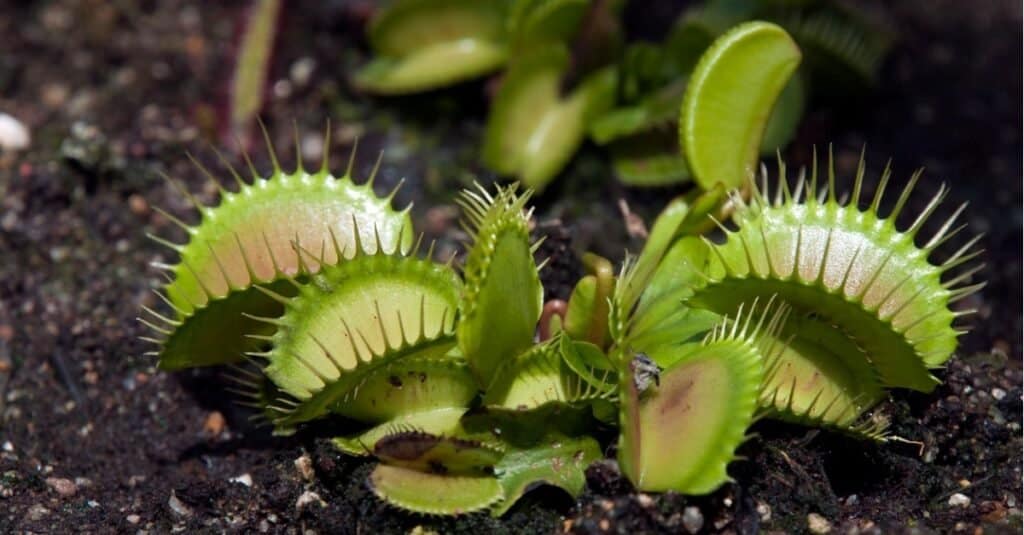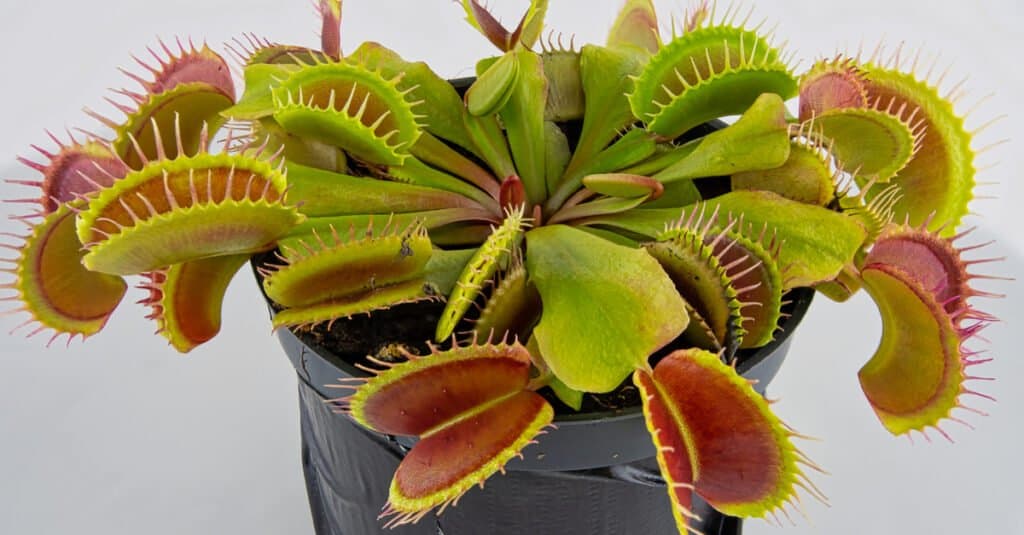Venus fly traps are some of the most interesting plants in the U.S. They’re only found in a small section on the East Coast, but their most interesting trait is that they’re carnivorous. They can eat many different types of insects and more. Does that mean that Venus fly traps eat hornets?
We’ll take a look at the typical food that Venus fly traps eat as well as the challenges posed by eating a hornet. By the time we’ve finished, you’ll know whether they can eat these insects and why that’s the case. Let’s get started by considering the food that Venus fly traps eat most often.
What Do Venus Fly Traps Eat?

The Venus fly trap is a carnivorous plant.
©Linda Blazic-Mirosevic/Shutterstock.com
Venus fly traps eat a variety of foods, including arthropods, arachnids, and insects. In particular, they consume insects that crawl on the ground, like ants, beetles, spiders, and grasshoppers. After all, these animals have a much lower chance of escaping their grasp once the plant springs its traps.
Interestingly, Venus fly traps select prey based on its size, to an extent. These plants will partially close their traps before closing entirely. That way, the plant can determine if the prey is large enough to provide nutrition greater than the effort involved with catching and digesting them.
Some creatures are too large, though. For example, an earthworm would be too big for the Venus fly trap to consume in its traps. Let’s take a closer look at how these animals manage to catch and consume their prey.
How Do Venus Fly Traps Catch Prey?
Venus fly traps make use of an interesting mechanism to attract and catch their prey. These plants emit volatile organic compounds that mimic the scents of flowers and fruit. The insects follow their senses to the plant.
Once there, the creature will find the traps lying open. These traps are actually specialized leaves that have two lobes. Each lobe has projections on the outer side called cilia that help prevent the prey from escaping.
Within the trap portion of the leaf are six total trigger hairs, three on each lobe. When a creature lands on or climbs into the leaf and triggers two of those hairs, the trap begins to close. Once the trap closes, it folds together, seals up, and begins to flood the area with enzymes to digest the creature. The creature is dissolved over the course of several days and then the trap reopens.
Can Creatures Escape the Venus Fly Trap?
Yes, some insects can escape this plant’s grasp. A few elements can contribute to an animal’s ability to get away before the trap closes.
First off, some creatures are too quick for the trap. The Venus fly trap starts to close within 1/10 of a second after the trigger hairs are disturbed. However, some flying insects can react so fast that they can pull themselves out of the closing trap and live to fight another day.
Secondly, some creatures are just too large for the trap to capture. We’ve already mentioned how an earthworm is an impractical choice of prey for these plants. After all, the traps are only about 1 to 1.5 inches long. If the traps cannot close around the creature, it will probably walk free after struggling out of the trap.
These are two of the most common ways for creatures to escape the Venus fly trap.
Can a Venus Fly Trap Eat Hornets?

Venus fly traps cannot eat hornets.
©iStock.com/Karin de Mamiel
No, a Venus fly trap cannot eat hornets. At least, that’s the case with the common European hornet. Simply put, the average hornet is just too large for the traps on the Venus fly trap to consume. Hornets have round bodies that can measure up to 2 inches long. That is longer than the entire length of most Venus fly traps’ leaves, so it would be very difficult for the trap to catch this insect.
Another thing to keep in mind is that hornets are also flying insects. Once they feel the trap start to close on their large bodies, they can simply back out of the closing leaf or quickly take to the skies. Either way, it is not very likely for a Venus fly trap to eat hornets.
Interestingly, this plant can eat a wasp. These flying creatures measure between 0.25 and 1 inch in total length. That’s small enough for a Venus fly trap to close around them.
All in all, though, it’s less likely for a flying animal to get caught by this particular plant. It’s much more likely that the Venus fly trap will close around spiders, beetles, or ants than flies and bees.
What Eats a Venus Fly Trap?
Venus fly traps are eaten by small mammals like birds, squirrels, and raccoons. The biggest threat to these plants is humans, though. People like to dig up these plants and take them home or attempt to sell them to nurseries. Also, these plants are facing habitat losses as a result of the continued development of land near the coasts in North and South Carolina where they grow.
Is a Venus Fly Trap a Plant?

The Venus fly trap is a plant.
©Craig Russell/Shutterstock.com
Yes, the Venus fly trap is a plant despite consuming other creatures. This may seem like an inversion of the usual situation where animals eat plants. Despite gaining a portion of its nutrition from its prey, the Venus fly trap can still perform photosynthesis.
The Venus fly trap is not an unusual type of plant. Actually, more than 600 different species of carnivorous plants have been identified throughout the world. Some of them are so large that they can eat rats, frogs, and even small birds!
All in all, these plants are very interesting. Yet, when we ask if Venus fly traps eat hornets, the answer is that they most likely cannot.
Up Next:
- Do Venus Flytraps Eat Wasps?
- How Big Was the Largest Venus Flytrap Ever?
- Venus Flytrap Seeds: Grow Your Own Carnivorous Plant!
The photo featured at the top of this post is © Menno van der Haven/Shutterstock.com
Sources
- U.S. Fish & Wildlife Service (1970) fws.gov/species/venus-fly-trap-dionaea-muscipula
- (1970)
Thank you for reading! Have some feedback for us? Contact the AZ Animals editorial team.







